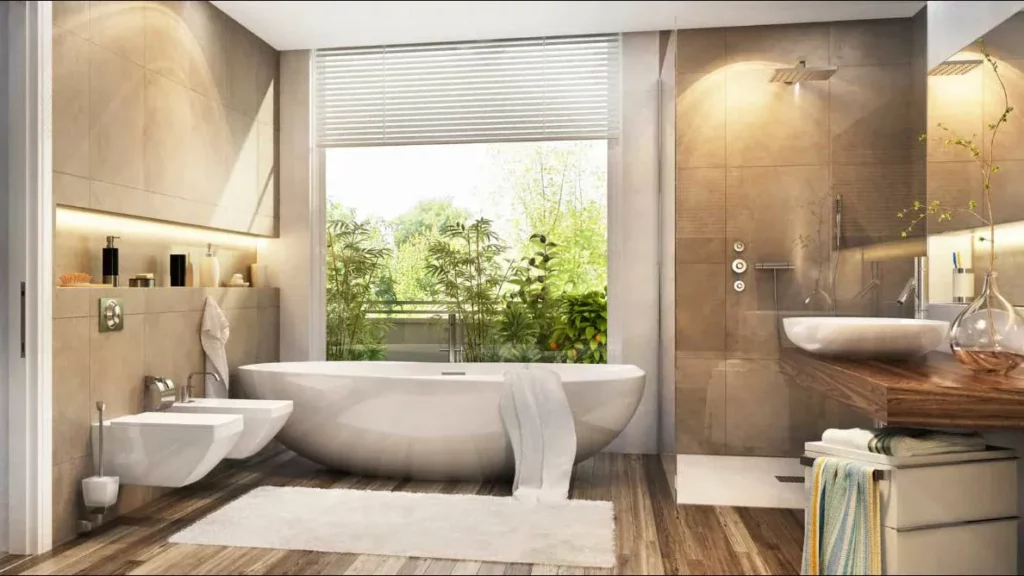The journey of a thousand miles, as they say, begins with one step. In the realm of interior design and home renovation, this adage holds true in an intriguingly literal sense.
The transformation process from an ordinary bathroom into a personal sanctuary starts with a blueprint – a detailed plan that serves as the bedrock for all subsequent stages of remodeling. This initial stage could be compared to the delicate artistry involved in creating a masterpiece painting; each line and shading on the canvas represent decisions that will ultimately shape the final outcome – color schemes, fixtures’ placement, materials’ selection etc., are all integral elements of this grand design.
Moving from planning to implementation is akin to watching a captivating symphony come alive note by note. It requires meticulous attention to detail and extensive knowledge about current design trends and construction techniques. Each element must harmonize perfectly with others within the spatial constraints while fulfilling its functional purpose efficiently. To achieve this melange of aesthetics and utility successfully is no small feat—it necessitates not only creativity but also management acumen.
This article aims to guide readers on their path towards crafting their dream bathroom remodeling design—starting from sketching out an effective blueprint to finally witnessing its beauty unfold piece by piece. So whether yearning for a minimalist modern sanctuary or dreaming of an opulent vintage retreat, readers can find insights here that resonate with their unique visions, helping them feel part of an exclusive community who value personalized living spaces that mirror their individual identities.
Planning Your Bathroom Remodel
According to a report by HomeAdvisor, homeowners spend an average of $10,000 to $15,000 on bathroom remodels, underscoring the importance of meticulous planning in such projects.
The initial phase involves identifying personal needs and desires for the new space along with assessing the existing layout’s functionality. It is crucial to consider elements such as plumbing configuration and lighting schemes that will affect both the aesthetics and practicality of the space. Additionally, understanding local building codes and securing necessary permits should not be overlooked since non-compliance can lead to costly rectifications.
The second step in planning a bathroom remodel focuses on designing an accommodating environment that harmonizes with the homeowner’s lifestyle while reflecting current design trends. Provoking thought towards materials selection for flooring, cabinetry, fixtures and color palettes is essential at this juncture. Not only do these choices influence visual appeal but they also contribute significantly to long-term maintenance requirements and overall project cost. A well-informed choice between trending options like freestanding tubs versus walk-in showers or marble countertops versus quartz could potentially save substantial amounts on future upkeep.
Attention then shifts towards establishing a realistic timeline for project completion which necessitates careful coordination of labor resources alongside materials acquisition. This stage often proves challenging due to unpredictable scenarios like product delays or unexpected structural discoveries during demolition that could cause deviations from original plans. However, with rigorous scheduling that factors in contingency time buffers along with diligent supervision over progress milestones; homeowners can mitigate potential roadblocks ensuring smooth transition from blueprint vision to beautiful reality within their dream bathroom remodeling design.
Implementing Your Bathroom Design
Implementing a bathroom design necessitates critical decisions such as selecting appropriate materials and fixtures, which not only resonate with the overall aesthetic but also promise durability and functionality.
The process also requires deliberate contemplation on whether to engage professionals for execution or undertake a do-it-yourself approach, each option presenting its unique advantages and challenges.
Further considerations encompass efficient management of the construction process to ensure timely completion while addressing potential disruptions, in addition to meticulous attention to finishing touches and details that elevate the final outcome from ordinary to exquisite.
Choosing Your Materials
Choosing your materials
Selecting the appropriate materials is a critical aspect of a bathroom remodeling project, as it can significantly impact both the aesthetic appeal and functionality of the space. The choice between ceramic, porcelain, or natural stone for flooring and wall tiles has long-term implications regarding maintenance and durability.
Similarly, decisions about vanity material – whether to opt for wood, laminate or solid surface – can affect not just visual aesthetics but also longevity and resistance to water damage. Furthermore, choices in regards to fixtures such as bathtubs and sinks – whether they be acrylic, cast iron or fiberglass – are equally consequential.
While each material has its merits in terms of aesthetics and functionality, considerations must extend beyond mere visual appeal. The following factors should be kept in mind when making these selections:
1. Durability: Materials should withstand daily wear-and-tear while maintaining their visual appeal.
2. Maintenance: Consider the level of care needed for different materials; some may require more frequent cleaning or special treatment.
3. Sustainability: Eco-friendly materials are becoming increasingly popular due to environmental concerns; consider this when choosing your materials.
4. Cost-effectiveness: Balancing quality with budget constraints is crucial; high-quality materials may result in longer-lasting results and fewer repairs down the line.
In essence, well-informed decisions on material selection can transform an ordinary bathroom into an extraordinary one while ensuring that it remains functional and beautiful over time. Therefore, it’s essential to take these considerations into account during your bathroom remodeling project for a satisfying outcome that fulfills your dream design aspirations while fostering a sense of belonging within your cherished living spaces.
Selecting Your Fixtures
Fixtures stand as the functional jewels within a bathroom’s crown, their choice reflecting not only aesthetic preference but also practical considerations of use and maintenance.
The selection of fixtures such as faucets, showerheads, and toilets necessitates a careful balance between style and function. For instance, while waterfall faucets may exude an air of luxury, they might not be suitable for all users due to their unique flow pattern or higher cost. Similarly, low-flow toilets or showerheads can offer significant water savings over time but may require adjustment from those accustomed to traditional flow rates. These decisions should be made in conjunction with other design choices such as material selections to ensure that the overall bathroom design is cohesive and harmonious.
When it comes to fixture finishes, homeowners have a multitude of options available. Popular choices include polished chrome for its timeless appeal and ease of cleaning; brushed nickel for its warm tone and ability to hide fingerprints; oil-rubbed bronze for its rich color and old-world charm; or matte black for a modern minimalist look. However, one must remember that while finishes do add character to the space, they should ultimately complement other elements within the room rather than compete with them. Furthermore, durability is another key factor since bathrooms are often subjected to high levels of moisture and humidity which could potentially degrade certain finishes over time.
Thus, selecting fixtures requires informed decision-making grounded in knowledge about both current trends in interior design as well as practical issues related to usage patterns and maintenance requirements.
Hiring Professionals or DIY
Navigating the decision between employing professional services or undertaking a do-it-yourself (DIY) approach to a bathroom renovation can often be a complex and challenging process.
The choice largely depends on the depth of renovation, budget restrictions, and personal willingness to engage in hands-on work.
Engaging professionals ensures optimal utilization of space, adherence to local building codes, high-quality workmanship, and timely project completion. However, this option could potentially strain financial resources due to labor costs.
On the other hand, the DIY route may seem economically appealing but requires significant time investment, construction proficiency, and can risk subpar results if not executed correctly.
Balancing these factors necessitates an assessment of personal abilities versus project demands.
For simple tasks such as fixture replacement or painting, a DIY approach might suffice given appropriate tools and basic knowledge at hand.
Conversely, for intricate design implementations involving plumbing or electrical works that require specialized skills and certifications – professional assistance becomes indispensable.
Ultimately, it is valuable to remember that every choice made contributes towards constructing not merely a functional space but also an intimate haven reflective of individual taste and lifestyle preferences.
Thus investing in professional expertise or dedicating personal effort should align with achieving this overarching goal seamlessly.
Managing the Construction Process
Transitioning from the decision-making process of whether to hire professionals or undertake a do-it-yourself approach, the focus now shifts towards an equally pivotal aspect: managing the construction process. This phase is crucial as it ensures that your dream bathroom remodeling design materializes in line with your envisioned blueprint and time frame.
The construction process management involves several interrelated procedures, which collectively contribute to achieving the desired outcome. Firstly, it encompasses regular monitoring of ongoing work to ascertain its alignment with the initial plan.
Secondly, it calls for efficient resource allocation and usage tracking. Lastly, effective communication with all parties involved is critical in promptly addressing any arising issues and facilitating smooth operations.
1. Regular Monitoring: Keeping a close eye on daily progress helps identify any discrepancies early enough for corrective measures to be instituted promptly.
2. Resource Allocation and Usage Tracking: Effective management of available resources such as labor, materials, tools, and time minimizes wastage and ensures optimal usage.
3. Effective Communication: Clear lines of communication enable swift resolution of problems while fostering a sense of camaraderie among team members leading to enhanced productivity.
By adhering to these guidelines during the construction phase of your bathroom remodeling project, you can ensure that even minute details align perfectly with your original vision – transforming what was once just a blueprint into tangible beauty within your home environment.
Finishing Touches and Details
Once the construction phase is satisfactorily completed, attention should then be directed to the final stage of a bathroom renovation project encompassing the addition of finishing touches and intricate details.
This entails refining design elements such as fixtures, lighting, mirrors, towel racks, and other essential accessories that are vital for functional aesthetics.
Selections should be aligned with the overall theme or style of the bathroom – from modern minimalistic to rustic farmhouse – while ensuring they meet practical needs in terms of size, positioning, and usage.
Furthermore, consideration must also be given to sourcing high-quality durable materials that will withstand frequent use over time without compromising on visual appeal.
The importance of this stage cannot be overstated as it provides an opportunity for personalization and character infusion into space.
Choosing unique pieces or custom-designed elements can create standout features that echo one’s personal style while enhancing the overall ambience of the room.
For instance, a beautifully framed mirror can serve as a statement piece in an otherwise understated design scheme; vintage-inspired brass fixtures can add warmth and depth to a predominantly white palette; or strategically placed lighting can highlight architectural features or add drama through shadow play.
The ultimate goal is to craft a space where every detail contributes towards creating not just a functional area but a personal sanctuary – embodying both beauty and utility in harmony – thereby fostering feelings of comfort, relaxation and belonging.
Palatial Paradises: Creating Luxurious Spaces With Bathroom Remodeling
Bathing In Brilliance: Essential Bathroom Remodeling Tips Revealed


